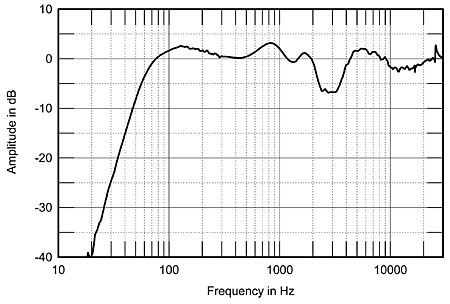| Columns Retired Columns & Blogs |
Linn Majik 109 loudspeaker Measurements
Sidebar 3: Measurements
The Linn Majik 109's voltage sensitivity is specified as 88dB/W/m at a single frequency, 1kHz. I prefer a broadband figure, as the sensitivity at one specific frequency can be misleading. My estimate of the Linn's B-weighted sensitivity was significantly lower than the specification, at 85dB(B)/2.83V/m. The speaker's impedance remained between 4 and 8 ohms over much of the audioband (fig.1), but did drop almost to 3 ohms in the mid-treble. Fortunately, the electrical phase angle is low at that frequency, ameliorating the drive difficulty.

Fig.1 Linn Majik 109, electrical impedance (solid) and phase (dashed). (2 ohms/vertical div.)
Some very slight discontinuities evident in the lower midrange in the traces in fig.1 suggest the presence of panel resonances of some kind. Investigating the cabinet's resonant behavior with a simple plastic-tape accelerometer, I did find modes present at 96, 260, and 352Hz (fig.2), but these are relatively well behaved. BJR didn't note any midrange congestion that might have resulted from this cabinet behavior.

Fig.2 Linn Majik 109, cumulative spectral-decay plot calculated from output of accelerometer fastened to center of side panel (MLS driving voltage to speaker, 7.55V; measurement bandwidth, 2kHz).
The behavior of the three drive-units and the port is shown in fig.3. The woofer's output is shown as the black trace in this graph; its minimum-motion notch occurs at 53Hz, slightly lower in frequency than the saddle between the two low-frequency impedance peaks in fig.1. The port's output (red trace) peaks between 50 and 90Hz, and its upper-frequency rollout is free from resonant effects, other than a low-level spike at 500Hz. The woofer peaks a little in the upper midrange before crossing over to the tweeter (green trace) at 1.5kHz. The tweeter's on-axis response is suppressed a little at the bottom of its passband, but the crossover to the supertweeter (blue trace) occurs at 6kHz, as specified. The supertweeter's output extends at full level to the 30kHz limit of this graph. The crossover's low-pass slopes all appear to be third-order; the supertweeter rolls in with a fourth-order slope.

Fig.3 Linn Majik 109, acoustic crossover on supertweeter axis at 50", corrected for microphone response, with nearfield responses of woofer (black) and port (red), plotted in the ratios of the square roots of their radiating areas below 350 and 625Hz, respectively.
Fig.4 shows how these individual driver outputs sum on the supertweeter axis in the farfield, with the trace below 300Hz showing the complex sum of the woofer and port outputs. There is only a slight boost apparent in the upper bass, which, when the nearfield measurement technique is taken into account, suggests that the Majik 109's woofer alignment is actually a little overdamped, trading off a lack of bass weight against articulation. BJR conjectured that the Majik 109 went lower than its specified 72Hz; the 6dB-down point lay at 60Hz.

Fig.4 Linn Majik 109, anechoic response on supertweeter axis at 50" with grille, averaged across 30° horizontal window and corrected for microphone response, with complex sum of woofer and port nearfield responses plotted below 300Hz.
While the overall response trend in fig.4 is fairly even, the primary characteristic is the severe lack of energy between 2 and 4kHz. This suckout affects the sensitivity calculation, which is why my figure was 3dB below Linn's—and as this region is where the ear is most sensitive, it should, all else being equal, lend the Majik 109's sound quality a rather distant, polite character. But all else is never equal, of course, and the balance perceived by the listener will also depend on the speaker's dispersion. Fig.5 shows the Majik 109's lateral dispersion, normalized to the response on the supertweeter axis: you can see that the on-axis suckout fills in to the speaker's sides. This graph indicates that the listener can balance politeness against top-octave air by experimenting with toe-in. In the vertical plane (fig.6), a suckout at the woofer/tweeter crossover frequency develops more than 5° above the supertweeter axis. Stands should be used to place the listener's ears level with or just below the supertweeter to get the smoothest treble balance.

Fig.5 Linn Majik 109, lateral response family at 50", normalized to response on supertweeter axis, from back to front: differences in response 90–5° off axis, reference response, differences in response 5–90° off axis.

Fig.6 Linn Majik 109, vertical response family at 50", normalized to response on supertweeter axis, from back to front: differences in response 45–5° above axis, reference response, differences in response 5–45° below axis.
Turning to the time domain, the Majik 109's step response on the supertweeter axis (fig.7) reveals that all three drivers are connected with positive acoustic polarity. The cumulative spectral-decay plot (fig.8) shows a relatively clean initial decay, but some low-level hash is evident at the top of the woofer's passband.

Fig.7 Linn Majik 109, step response on supertweeter axis at 50" (5ms time window, 30kHz bandwidth).

Fig.8 Linn Majik 109, cumulative spectral-decay plot on supertweeter axis at 50" (0.15ms risetime).
This beautifully finished little speaker does have some idiosyncrasies in its measured performance. The proof of the engineering lies in the listening, however, and I note that Bob Reina found very little to complain about.—John Atkinson
- Log in or register to post comments




































